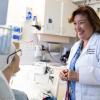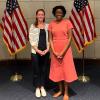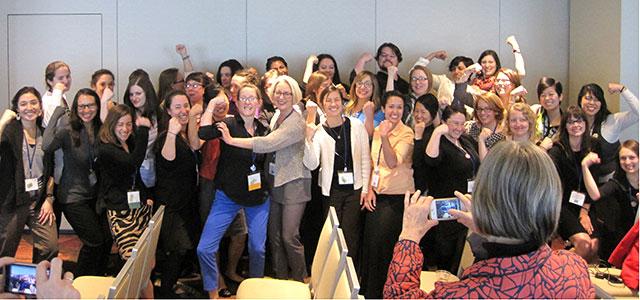
Nursing Students for Choice, with Diana Taylor (center)
Women’s Health Care Warrior
When Diana Taylor started nursing school in Oregon in the late 1960s, unmarried women couldn’t get prescriptions for birth control pills, abortion was illegal, women’s menstrual symptoms were not taken seriously, and there was no field of study known as “women’s health.”
To paraphrase a famous ad slogan of the era, women have come a long way since then, especially in terms of access to reproductive care and other health services that have greatly improved the quality of their lives. Colleagues say that Taylor, a professor emerita at UC San Francisco School of Nursing, has been a national leader in helping women achieve these gains.
Since becoming a nurse in 1972, Taylor has published more than 100 articles and five books on women’s health. She has served on various professional and public health boards and committees to improve patient care, practice standards and nursing’s professional stature. And at UC San Francisco, she headed the School of Nursing’s Women’s Health Nurse Practitioner Program, co-directed the Center for Collaborative Primary Care (which no longer exists) and mentored many future nurse scholars and leaders.
One such protégé is Debbie Bamberger, a graduate of the School of Nursing’s first Master’s Entry Program in Nursing (MEPN) class. With Taylor’s mentorship, Bamberger co-founded the Women’s Community Clinic, one of San Francisco’s only free clinics for women. Taylor serves on the clinic’s board of directors. “She’s a force to be reckoned with,” says Bamberger, now the lead clinician at Planned Parenthood Shasta Pacific’s El Cerrito clinic.
“She’s a trailblazer, who’s been at the forefront of policy changes for advancing practice and new models of health care for women,” adds Nancy Woods, professor at the University of Washington’s School of Nursing, who mentored Taylor as a doctoral student, when Taylor began her groundbreaking research on the effects of menstrual cycles on women’s health.
Taylor speaks of her accomplishments in more modest terms, but her voice assumes the force cited by Bamberger when she talks about nursing’s vital role in health care and her recent efforts to expand women’s access to abortions and comprehensive reproductive health services, causes she has been fighting for since the pre-Roe v. Wade era. Taylor may have emerita status, but she’s been as busy as ever. She is director of research and evaluation at UCSF’s Advancing New Standards in Reproductive Health (ANSIRH) and, with her colleagues, she helped develop training and research to support a law signed October 9 that allows nurse practitioners, certified nurse-midwives and physician assistants to perform what are called first-trimester aspiration abortions. These procedures, the most common type of in-clinic abortions, involve a handheld device or suction machine that empties the uterus.
Taylor has been in the news because of this law, and she was honored in June with the National Abortion Federation’s first-ever Clinicians for Choice Leadership Award for her contribution to removing abortion practice barriers.
She says the award brings her career “full circle” because it recognizes how she has always sought to advocate for women’s health care and to normalize abortion into women’s primary care. “That’s the basis of women’s health, to have choices and access to essential services,” Taylor says. “We might have rights, but without access, we have no rights at all.”
The Personal Is Political
Taylor’s career in nursing and women’s health care advocacy was born in the civil rights and counterculture struggles of the 1960s. Although she didn’t grow up in a family that debated current events around the dinner table, historical upheavals of that decade made it hard for a bright, intellectually curious young woman to avoid politics. Starting in high school, she volunteered for the National Association for the Advancement of Colored People, the National Urban League, local Vietnam War protest efforts and the campaign for Robert Kennedy’s 1968 presidential run.
Two wrenching events of 1968 occurred on days that were personal milestones for her. Martin Luther King Jr. was assassinated on April 4, the day Taylor turned 18. Then, on June 6, Taylor gave her high school graduation valedictory address as she and the rest of the nation were grappling with the news that Kennedy had been fatally shot in Los Angeles. “I saw the effects of politics and how your life can shift,” she says.
 Taylor cites another popular slogan of that era, “the personal is political,” in describing how she became politically awakened to women’s second-class status in American society.
Taylor cites another popular slogan of that era, “the personal is political,” in describing how she became politically awakened to women’s second-class status in American society.
As a young college student at Oregon State University, Taylor focused her activism on women’s reproductive rights after learning that only married women could get birth control pills at the student health center. If Taylor and her friends wanted to be sexually active, they had to rely on their partners’ condoms, which sometimes broke, leading to unintended pregnancies.
That’s what happened to one of Taylor’s good friends. Unfortunately, the friend didn’t have the thousands of dollars needed to pay a doctor in the United States to perform an abortion. Running out of time, the young woman’s only choice – besides carrying the pregnancy to term – was to go to Mexico for a “back-alley” procedure.
It left the woman infertile. “I was beginning to see how access to birth control and abortion was central to the way women were being discriminated against,” says Taylor.
In response, she volunteered for what later became a new Planned Parenthood clinic in Portland. She also became involved in West Coast efforts inspired by the Abortion Counseling Service of the Chicago Women’s Liberation Union, whose underground “Jane” movement sent activists into women’s living rooms to educate them about reproductive health and menstrual extractions, a technique used by women in many parts of the world to bring on their periods and terminate early pregnancies.
“It was very much an Our Bodies, Ourselves kind of thing,” Taylor says. Guided by volunteer nurses and experienced activists, Taylor helped women learn to safely perform this simple, nontraumatic procedure themselves, using a cannula, or tube, to suction out blood during a heavy menstrual period – or a fertilized egg.
“For women who had missed their period or thought they might be pregnant, we’d do a menstrual extraction,” Taylor says. “Women would be scared and anxious. After the procedure, we could see how relieved they were.”
The Professional Is Political
Those experiences prompted Taylor to switch to the University of Oregon and study nursing. It was an exciting time to be entering the profession, she says. Her curriculum there emphasized public health nursing. She and other students made home visits to low-income, high-risk pregnant women and new mothers and babies. In keeping with nursing’s holistic view that quality care depends on safe and healthy environments, the visits included assessments to make sure these women had access to safe drinking water and were not exposed to domestic violence.
After graduation, she began her nursing career as a manager of a primary care clinic in Eugene. With the help of veteran nurses, she again redirected her activism, this time to public health issues. She joined professional organizations to advance policy changes, care practices and nursing’s professional stature.
“It was just a given that you got involved,” she says. In testifying before governmental agencies on public health issues or participating in collective bargaining, she deepened her appreciation for her profession, for the political nature of systems charged with improving the health of vulnerable populations – and for the nurses who were providing this care.
One early experience with successful lobbying echoes in her current work to expand nursing’s role in providing abortion services. In the mid-1970s, she helped the Oregon Nurses Association successfully make changes in Oregon law to allow advanced practice nurses to work to the full scope of their education and competency. Then, as now, Taylor says: “We were first and foremost focused on patient needs, but using political and policy tools to advance the nursing profession, so that we could do what we need to do for patients.”
The Birth of Women’s Health
Taylor was focusing again on women’s health, prompted in part by her final year of nursing school, when she and a classmate lobbied to take classes in the medical school, including a course in physical assessment and diagnosis. When the lecturing physician illustrated how to take a female patient’s gynecological history, he put fingers in each ear and said jokingly: “This is how you take a woman’s health history.” Taylor walked out.
Fortunately for Taylor, such attitudes were falling out of favor. At UC San Francisco School of Nursing, where Taylor earned her master’s degree in 1976, she was introduced to thinkers like sociologist Virginia Olesen, who had begun teaching the first courses in women’s health at UCSF in 1973 and would develop an international women’s health and healing curriculum in the 1980s.
Taylor credits Olesen and Woods, her soon-to-be-mentor at the University of Washington, with encouraging her to apply her growing research skills to a largely unexplored but crucial topic in women’s health: menstrual cycles.
PMS, Seriously
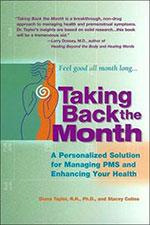 Taylor’s focus on PMS began after she graduated from UCSF and returned to Oregon to open a women’s health clinic. “Because of our unique model of women’s health care – a focus on personal and biopsychosocial determinants – women told me about symptoms that seemed to recur around the time of menstruation, distressing symptoms that compromised their ability to function and the quality of their lives,” Taylor wrote in her 2002 book Taking Back the Month: A Personalized Solution for Managing PMS and Enhancing Your Health.
Taylor’s focus on PMS began after she graduated from UCSF and returned to Oregon to open a women’s health clinic. “Because of our unique model of women’s health care – a focus on personal and biopsychosocial determinants – women told me about symptoms that seemed to recur around the time of menstruation, distressing symptoms that compromised their ability to function and the quality of their lives,” Taylor wrote in her 2002 book Taking Back the Month: A Personalized Solution for Managing PMS and Enhancing Your Health.
Ever mindful of Florence Nightingale’s holistic approach to health care, Taylor had a hunch that an integrated approach to PMS management could work for many women, but found little scholarly research on the topic. Even within the emerging field of women’s health, most clinicians in the 1970s still didn’t take back pain, cramps, bloating, sleep disturbances or mood swings seriously, Taylor noted.
Taylor was determined to change all that. First, in developing a menstrual disorders program at Oregon Health and Science University’s School of Nursing, then with her doctoral research at the University of Washington and finally when she returned to UCSF as an assistant professor, she looked at how hormonal changes occurring monthly and over the span of a woman’s life affected all emotional, social and physical aspects of her life.
In her Premenstrual Symptom Management Program at UCSF, she focused on nondrug treatments for PMS. “Women wanted and needed scientific evidence about which remedies were merely folk cures, whether dietary changes work better than exercise and whether there could be a one-size-fits-all treatment, as many other researchers have suggested,” she wrote.
As it turned out, Taylor’s research, which incorporated the experiences of more than 500 women, discounted the one-size-fits-all approach but empowered women to identify their individual needs. If hormone therapy and other medical treatments helped reduce the severity of their symptoms, they might also find relief in nonmedical interventions. Taylor was eager to share this information with women and partnered with health writer Stacey Colino to pen Taking Back the Month, which offers accessible, consumer-friendly tips on managing the menstrual cycle.
“She’s very much a pioneer in translating research and finding a way to share it with the public in a way that is accessible,” says Woods of Taylor.
During her time on the UCSF faculty, Taylor also directed the Women’s Health Nurse Practitioner Program and the Center for Collaborative Primary Care. She also continued to instill an appreciation for public health in her students. And just as she was mentored as a young nurse, she continues to mentor UCSF students.
“She models for me the kind of nurse scientist I want to become,” says Assistant Professor Monica McLemore, who had Taylor as her postdoctoral mentor.
Angel James, an ANSIRH research resident and doctoral student in the School of Nursing, said Taylor was so supportive of her interest in preventing unintended pregnancies that she gave her the opportunity to work with her on several publications. James especially appreciated Taylor’s advice on becoming more politically savvy to get her research noticed. “She reminds me that the work we do is incredibly important and we need to get it out there,” says James.
Back in the Trenches
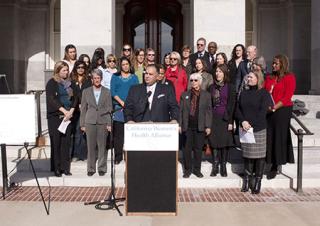 Diana Taylor at the 40th anniversary of Roe v. Wade in Sacramento Over the years, Taylor, like other early abortion supporters, has watched in dismay as violence, blockades of clinics, and state and federal restrictions have encroached on the rights guaranteed to women under Roe v. Wade.
Diana Taylor at the 40th anniversary of Roe v. Wade in Sacramento Over the years, Taylor, like other early abortion supporters, has watched in dismay as violence, blockades of clinics, and state and federal restrictions have encroached on the rights guaranteed to women under Roe v. Wade.
After she retired from the School of Nursing in 2003, Taylor came to ANSIRH, a program of the Bixby Center for Global Reproductive Health. In addition to collaborating with James and other scholars on research to prevent unintended pregnancies, she worked with Tracy Weitz, ANSIRH’s director and an associate professor in UCSF School of Medicine’s Department of Obstetrics, Gynecology and Reproductive Sciences, on the Health Workforce Pilot Project (HWPP). This six-year, multisite study provided scientific evidence in favor of Assembly Bill 154, the recently signed California law expanding access to abortion services.
Before the bill became law in October, only trained physicians were allowed to perform surgical abortions (an outdated term that has not caught up with technology advances) in California, leaving more than half of the state’s 58 counties without abortion providers. Results of the HWPP study, published in the American Journal of Public Health in March 2013, found that newly trained nurse practitioners, nurse-midwives and physician assistants had similarly low rates of complications from aspiration abortions as physicians.
For Democratic Assembly member Toni Atkins, the study bolstered one of her arguments in favor of AB154: This type of abortion is a simple, nonsurgical procedure that can be performed in an outpatient setting.
For Taylor, the new law fulfills some of her overarching career goals: to integrate early abortion into women’s primary health care and to make it available as a secondary method (after contraception) for avoiding or minimizing unwanted pregnancies.
“We have the highest unintended pregnancy rate in industrialized societies, and it hasn’t budged in 20 years,” she says. “If you look at countries with national health services and abortions integrated into primary care, you see much lower rates of unintended pregnancy and abortion.”
Receiving the Clinicians for Choice Leadership Award and seeing the bill she worked so hard for become law together make a nice bookend to her career. Taylor figures she will retire for real one day, but says she will never step back from advocating for women’s reproductive rights and public health justice.
“There is more work to do,” she says, simply. She worries especially about ongoing political efforts to restrict women’s access to essential health care, including contraception, sexual health promotion and abortion. “But I still have hope because of the smart, dedicated, strategic young leaders and health professionals coming up to take my place.”


